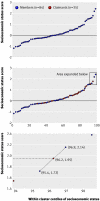Equitable utilisation of Indian community based health insurance scheme among its rural membership: cluster randomised controlled trial
- PMID: 17526594
- PMCID: PMC1895633
- DOI: 10.1136/bmj.39192.719583.AE
Equitable utilisation of Indian community based health insurance scheme among its rural membership: cluster randomised controlled trial
Abstract
Objective: To evaluate alternative strategies for improving the uptake of benefits of a community based health insurance scheme by its poorest members.
Design: Prospective cluster randomised controlled trial.
Setting: Self Employed Women's Association (SEWA) community based health insurance scheme in rural India. Participants 713 claimants at baseline (2003) and 1440 claimants two years later among scheme members in 16 rural sub-districts.
Interventions: After sales service with supportive supervision, prospective reimbursement, both packages, and neither package, randomised by sub-district.
Main outcome measures: The primary outcome was socioeconomic status of claimants relative to members living in the same sub-district. Secondary outcomes were enrolment rates in SEWA Insurance, mean socioeconomic status of the insured population relative to the general rural population, and rate of claim submission.
Results: Between 2003 and 2005, the mean socioeconomic status of SEWA Insurance members (relative to the rural population of Gujarat) increased significantly. Rates of claims also increased significantly, on average by 21.6 per 1000 members (P<0.001). However, differences between the intervention groups and the standard scheme were not significant. No systematic effect of time or interventions on the socioeconomic status of claimants relative to members in the same sub-district was found.
Conclusions: Neither intervention was sufficient to ensure that the poorer members in each sub-district were able to enjoy the greater share of the scheme benefits. Claim submission increased as a result of interventions that seem to have strengthened awareness of and trust in a community based health insurance scheme. Trial registration Clinical trials NCT00421629.
Trial registration: ClinicalTrials.gov NCT00421659.
Conflict of interest statement
Figures



Comment in
-
Community based health insurance in developing countries.BMJ. 2007 Jun 23;334(7607):1282-3. doi: 10.1136/bmj.39240.632963.80. BMJ. 2007. PMID: 17585121 Free PMC article.
Similar articles
-
Measuring improved targeting of health interventions to the poor in the context of a community-randomised trial in rural India.Contemp Clin Trials. 2007 Jul;28(4):382-90. doi: 10.1016/j.cct.2006.10.008. Epub 2006 Oct 14. Contemp Clin Trials. 2007. PMID: 17126613 Clinical Trial.
-
Making health insurance work for the poor: learning from the Self-Employed Women's Association's (SEWA) community-based health insurance scheme in India.Soc Sci Med. 2006 Feb;62(3):707-20. doi: 10.1016/j.socscimed.2005.06.037. Epub 2005 Jul 28. Soc Sci Med. 2006. PMID: 16054740
-
The effect of community health worker-led education on women's health and treatment-seeking: A cluster randomised trial and nested process evaluation in Gujarat, India.J Glob Health. 2017 Dec;7(2):020404. doi: 10.7189/jogh.07.020404. J Glob Health. 2017. PMID: 28959438 Free PMC article. Clinical Trial.
-
Helping members of a community-based health insurance scheme access quality inpatient care through development of a preferred provider system in rural Gujarat.Natl Med J India. 2006 Sep-Oct;19(5):274-82. Natl Med J India. 2006. PMID: 17203684 Free PMC article.
-
Barriers to accessing benefits in a community-based insurance scheme: lessons learnt from SEWA Insurance, Gujarat.Health Policy Plan. 2006 Mar;21(2):132-42. doi: 10.1093/heapol/czj010. Epub 2005 Dec 22. Health Policy Plan. 2006. PMID: 16373360
Cited by
-
Assessing effectiveness of a community based health insurance in rural Burkina Faso.BMC Health Serv Res. 2012 Oct 19;12:363. doi: 10.1186/1472-6963-12-363. BMC Health Serv Res. 2012. PMID: 23082967 Free PMC article.
-
Factors Determining the Enrolment in Community-based Health Insurance Schemes: A Cross-sectional Study from Coastal South India.Indian J Community Med. 2018 Oct-Dec;43(4):312-315. doi: 10.4103/ijcm.IJCM_118_18. Indian J Community Med. 2018. PMID: 30662187 Free PMC article.
-
Health insurance coverage and access to child and maternal health services in West Africa: a systematic scoping review.Int Health. 2023 Nov 3;15(6):644-654. doi: 10.1093/inthealth/ihad071. Int Health. 2023. PMID: 37609993 Free PMC article.
-
Health worker preferences for community-based health insurance payment mechanisms: a discrete choice experiment.BMC Health Serv Res. 2012 Jun 14;12:159. doi: 10.1186/1472-6963-12-159. BMC Health Serv Res. 2012. PMID: 22697498 Free PMC article.
-
Provider payment in community-based health insurance schemes in developing countries: a systematic review.Health Policy Plan. 2013 Mar;28(2):111-22. doi: 10.1093/heapol/czs034. Epub 2012 Apr 19. Health Policy Plan. 2013. PMID: 22522770 Free PMC article.
References
-
- Gwatkin DR, Rustein S, Johnson K, Pande RP, Wagstaff A. Socio-economic differences in health, nutrition and population in India Washington, DC: World Bank, 2000
-
- Xu K, Evans DB, Kawabata K, Zeramdini R, Klavus J, Murray CJL. Household catastrophic health expenditure: a multicountry analysis. The Lancet 2003;362:111-7. - PubMed
-
- Schieber G, Baeza C, Kress D, Maier M. Financing health systems in the 21st century. In: Jamison DT, Breman JG, Measham AR, Alleyne G, Claeson M, Evans DB, et al, eds. Disease control priorities in developing countries 2nd ed. New York: Oxford University Press, 2006:1401.
Publication types
MeSH terms
Associated data
Grants and funding
LinkOut - more resources
Full Text Sources
Medical
